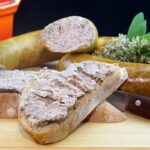
Dark, rich, and centuries old, Blutwurst (blood sausage) might be one of Germany’s most misunderstood culinary treasures. While it may raise eyebrows among the uninitiated, this hearty sausage is revered throughout German-speaking regions – especially in Rhineland, Saxony, and Bavaria.
Made with pork blood, fat, and spices, Blutwurst is a comfort food steeped in rural tradition and nose-to-tail cooking. Whether eaten cold on rye bread or sliced and pan-fried with sauerkraut, it reflects a deep respect for resourceful, flavorful cuisine.
In this article, you’ll learn about Blutwurst’s history, key ingredients, regional styles, how to serve it, and even a traditional home-style recipe.
History and Tradition of Blutwurst
Blutwurst has been part of German butchering culture since the Middle Ages, originally crafted during winter pig slaughters to make use of every part of the animal. It’s one of the earliest examples of sustainable, whole-animal cooking.
In many rural areas, blood sausage was a celebratory food shared after a successful slaughter. Its rich flavor and dense texture made it ideal for warming up during cold seasons.
Today, Blutwurst remains popular across Germany and neighboring countries, with dozens of regional versions and serving traditions.
What’s in Blutwurst?
Blutwurst is typically fully cooked and ready to eat, often served cold, though certain types are best warmed or pan-fried.
Common Ingredients:
- Pork blood (gives the sausage its dark color)
- Pork fat (cubed or ground)
- Pork rind or snout (adds gelatin and texture)
- Barley or oats (optional, for bulk and body)
- Onions
- Salt and pepper
- Spices: marjoram, allspice, cloves, nutmeg, thyme
In northern Germany, it’s often made smooth and sliceable, while in the south it may include larger visible chunks of fat or rind.
Key Regional Varieties
1. Rheinische Blutwurst (Rhineland)
- Mildly spiced, often smoked
- Served warm with sauerkraut and mashed potatoes
- Key ingredient in Himmel und Erde (“Heaven and Earth”) – mashed potatoes, apple compote, and fried Blutwurst
2. Thüringer Rotwurst
- Coarser texture, heavily spiced
- Often eaten cold on rye bread or grilled
3. Bayerische Blutwurst (Bavaria)
- Made with pork rind and fat chunks
- Smoky, sometimes eaten warm with sweet mustard
4. Westfälische Blutwurst
- Fine texture, often smoked and canned
- Served on hearty Westphalian rye bread
How to Make Traditional Blutwurst at Home
Homemade Blutwurst requires basic sausage-making skills and access to fresh pork blood (from a trusted butcher or farm).
Ingredients (yields ~2 kg):
- 1 liter fresh pork blood
- 500 g pork belly or shoulder
- 300 g pork fat, cubed
- 200 g cooked barley or oats (optional)
- 1 onion, sautéed
- 20 g salt
- 1/2 tsp black pepper
- 1/2 tsp marjoram
- 1/4 tsp allspice or cloves
- Natural casings, or use jars for storage
Instructions:
- Cook pork belly until tender, chop finely.
- Render fat until soft, drain excess liquid.
- Combine blood, meat, fat, barley, onion, and seasonings. Stir until uniform.
- Stuff into cleaned casings or sterilized jars.
- Gently simmer in water at 80–85°C (175–185°F) for about 90 minutes.
- Cool in an ice bath and store refrigerated.
Blutwurst can be eaten cold or fried in slices until crisp.
How to Serve Blutwurst
Blutwurst is traditionally served in three main ways:
1. Cold on Bread
- Sliced thinly on rye or sourdough
- Topped with mustard, pickles, or onions
2. Warm with Sauerkraut
- Heated gently or pan-fried
- Served with sauerkraut and mashed potatoes or boiled potatoes
3. Fried in Dishes
- Fried in slices until crispy
- Used in regional specialties like:
- Himmel und Erde (Rhineland)
- Rotwurst mit Kraut (Thuringia)
Tips for Cooking Blutwurst
- Do not overheat – it may split or leak if boiled
- Slice when cold for cleaner cuts
- Pan-fry slowly until the outside is crisp but the inside remains soft
- Pairs beautifully with apple, onion, and vinegar-based accompaniments
Storage and Shelf Life
- Fresh Blutwurst: 4–5 days refrigerated
- Vacuum-sealed or canned Blutwurst: several months
- Can be frozen, though texture may soften slightly
Blutwurst Fun Facts
- Blutwurst is related to blood sausages in many cultures – like black pudding (UK), boudin noir (France), and morcilla (Spain).
- In Germany, it’s sometimes affectionately nicknamed “Rotwurst” (red sausage).
- The German Butchers’ Association awards an annual prize for the best Blutwurst.
- In Cologne, Blutwurst is paired with Kölsch beer as a popular pub dish.
Blutwurst may not be for the faint-hearted, but for those who appreciate bold, traditional flavors, it’s a deeply satisfying and culturally rich dish. Whether you enjoy it cold on rustic rye bread or pan-fried with apples and sauerkraut, German blood sausage is a powerful reminder of old-world butchery and regional pride.
Curious to explore more? Try the sweet-spicy Weisswurst of Bavaria, or experience Berlin’s cult favorite Currywurst for a completely different sausage journey and Strange German Foods Tourists Don’t Understand.







